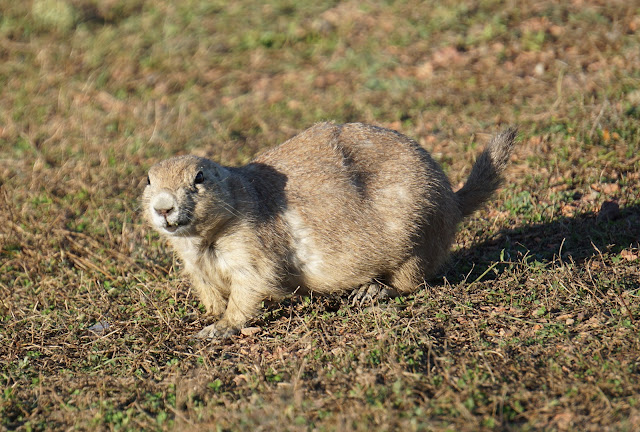September 14-15, 2019
Theodore Roosevelt National Park comprises over 70,000 acres (110 square miles) and gets about 800,000 visitors a year. Roosevelt's experiences here in the 1880s and 1890s influenced his pursuit of conservation policies as President of the United States from 1901 to 1909, so it seems appropriate that it is now a national park.
The Park started out as the Theodore Roosevelt National Wildlife Refuge in 1946. In 1947 and 1948, two parts of it were designated as The Theodore Roosevelt National Memorial Park, the first (and last) Memorial Park ever established, and in 1978 it received its current name and status.
The park is known for its wildlife, and we were excited to get "up-close and personal" with some if it . . . until we saw these signs:
I like the "rule of thumb" at the bottom of this one:
I spent parts of two days in the park, and Bob, who got up VERY early in the morning on the day we flew home so that he could spend more time in the park while I slept, spent parts of of three days there.
Roosevelt spent much of his time in an area called "the badlands." "Badlands" is a generic term for a type of terrain characterized by eroded sedimentary rock with steep faces, unusual rock formations, deep ravines, minimal vegetation, and often unusual color displays.
The Little Missouri River, a 560-mile-long tributary of the Missouri River, flows through all three sections of the national park. This is one of the iconic shots of the park, the River Bend Overlook:
The three photos of the river above were taken from this viewpoint, which is almost as picturesque as the valley:
The overlook shelter was built in the late 1930s by the Civilian Conservation Corps (CCC) and was designed to blend in with the landscape:
We spotted an animal track next to the trail--a bear?
This park is certainly a gem in North Dakota's crown. I had never heard of it before we started planning for this trip. It should rank as high as Yellowstone on your "must see" National Parks list.
We were there in early fall and caught glimpses of what must be a magnificent display of color that would come in a few weeks.
Of course, what really stood out (no pun intended) were the buffaloes--lots of buffaloes.
We've been watching the Netflix series The Crown, and I couldn't help but see the resemblance of this guy to Winston Churchill.
Some of my favorite photos of Bob are of him taking photos of wildlife. It is his passion.
Mama and baby:
A youngster going it alone. He must be in that awkward, moody pre-teen stage.
Buffalo always have the right-of-way on the roads.
This message was shared time and time again . . .
. . . but nowhere was it translated into Buffalo, and they didn't appear to be getting the message.
This feller taunted us by sauntering down the center of the road for about ten minutes. We crept along behind him at what Bob thought was a safe distance for what seemed like miles.
He finally moved off to the side and let us pass.
We saw a few small groups, and it wasn't hard to imagine the massive herds that used to roam this country. When the first European settlers arrived in North America, there were 25 to 30 million buffalo. By the late 1880s, fewer than 100 remained in the wild. North Dakota has played an important role in the comeback of the species.
They weren't too bothered by our presence.
A little more scarce are the wild Nokota horses, a breed developed in the 19th century when multiple breeds were interbred. The park maintains a herd of 70 to 110 horses.
We also saw wild turkeys . . .
. . . mule deer . . .
. . . and a beautiful sunset, the kind you would expect to see cowboys riding off into at the end of an old western.
 We listened to the audible book Theodore Roosevelt in the Badlands: A Young Politician's Quest for Recovery in the American West by Roger L. Di Silvestre while driving around eastern North Dakota--the very badlands to which Roosevelt fled after the deaths of his mother and then his wife on the same day in 1884. It was fun to be in the actual spots discussed in the book and to imagine young Roosevelt hunting buffalo, elk, and bear.
We listened to the audible book Theodore Roosevelt in the Badlands: A Young Politician's Quest for Recovery in the American West by Roger L. Di Silvestre while driving around eastern North Dakota--the very badlands to which Roosevelt fled after the deaths of his mother and then his wife on the same day in 1884. It was fun to be in the actual spots discussed in the book and to imagine young Roosevelt hunting buffalo, elk, and bear.Sometimes I got a little bogged down in all the people and details the author includes, but it was still the perfect listen for our trip as it covers only Roosevelt's childhood through his second marriage, with a lot of focus on his North Dakota experiences, and ends with a brief summary of the rest of his life.






















































I loved the national park - the best thing we visited in North Dakota, and there were lots of nice places to visit in North Dakota.
ReplyDelete